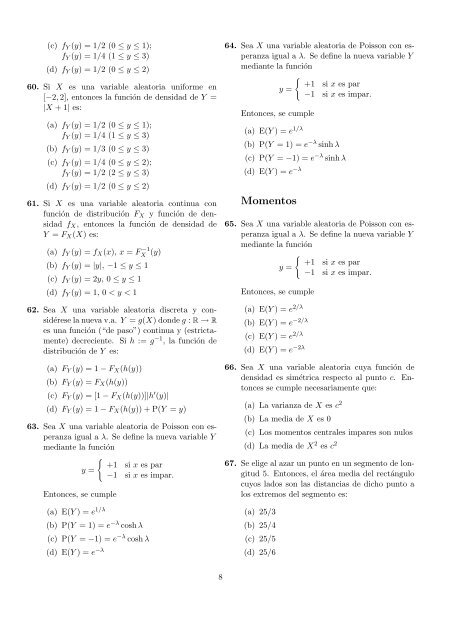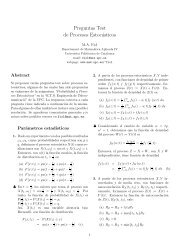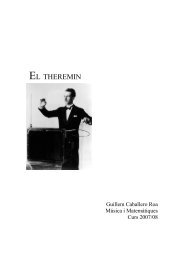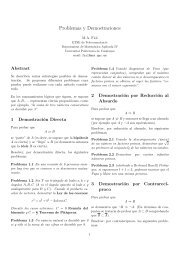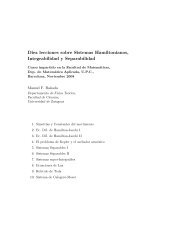100 Preguntas Test Probabilidad Combinatoria y Variables ...
100 Preguntas Test Probabilidad Combinatoria y Variables ...
100 Preguntas Test Probabilidad Combinatoria y Variables ...
- No tags were found...
Create successful ePaper yourself
Turn your PDF publications into a flip-book with our unique Google optimized e-Paper software.
(c) f Y (y) = 1/2 (0 ≤ y ≤ 1);<br />
f Y (y) = 1/4 (1 ≤ y ≤ 3)<br />
(d) f Y (y) = 1/2 (0 ≤ y ≤ 2)<br />
60. Si X es una variable aleatoria uniforme en<br />
[−2, 2], entonces la función de densidad de Y =<br />
|X + 1| es:<br />
(a) f Y (y) = 1/2 (0 ≤ y ≤ 1);<br />
f Y (y) = 1/4 (1 ≤ y ≤ 3)<br />
(b) f Y (y) = 1/3 (0 ≤ y ≤ 3)<br />
(c) f Y (y) = 1/4 (0 ≤ y ≤ 2);<br />
f Y (y) = 1/2 (2 ≤ y ≤ 3)<br />
(d) f Y (y) = 1/2 (0 ≤ y ≤ 2)<br />
61. Si X es una variable aleatoria continua con<br />
función de distribución F X y función de densidad<br />
f X , entonces la función de densidad de<br />
Y = F X (X) es:<br />
(a) f Y (y) = f X (x), x = F −1<br />
X (y)<br />
(b) f Y (y) = |y|, −1 ≤ y ≤ 1<br />
(c) f Y (y) = 2y, 0 ≤ y ≤ 1<br />
(d) f Y (y) = 1, 0 < y < 1<br />
62. Sea X una variable aleatoria discreta y considérese<br />
la nueva v.a. Y = g(X) donde g : R → R<br />
es una función (“de paso”) continua y (estrictamente)<br />
decreciente. Si h := g −1 , la función de<br />
distribución de Y es:<br />
(a) F Y (y) = 1 − F X (h(y))<br />
(b) F Y (y) = F X (h(y))<br />
(c) F Y (y) = [1 − F X (h(y))]|h ′ (y)|<br />
(d) F Y (y) = 1 − F X (h(y)) + P(Y = y)<br />
63. Sea X una variable aleatoria de Poisson con esperanza<br />
igual a λ. Se define la nueva variable Y<br />
mediante la función<br />
{<br />
+1 si x es par<br />
y =<br />
−1 si x es impar.<br />
Entonces, se cumple<br />
(a) E(Y ) = e 1/λ<br />
(b) P(Y = 1) = e −λ cosh λ<br />
(c) P(Y = −1) = e −λ cosh λ<br />
(d) E(Y ) = e −λ<br />
64. Sea X una variable aleatoria de Poisson con esperanza<br />
igual a λ. Se define la nueva variable Y<br />
mediante la función<br />
{<br />
+1 si x es par<br />
y =<br />
−1 si x es impar.<br />
Entonces, se cumple<br />
(a) E(Y ) = e 1/λ<br />
(b) P(Y = 1) = e −λ sinh λ<br />
(c) P(Y = −1) = e −λ sinh λ<br />
(d) E(Y ) = e −λ<br />
Momentos<br />
65. Sea X una variable aleatoria de Poisson con esperanza<br />
igual a λ. Se define la nueva variable Y<br />
mediante la función<br />
{<br />
+1 si x es par<br />
y =<br />
−1 si x es impar.<br />
Entonces, se cumple<br />
(a) E(Y ) = e 2/λ<br />
(b) E(Y ) = e −2/λ<br />
(c) E(Y ) = e 2/λ<br />
(d) E(Y ) = e −2λ<br />
66. Sea X una variable aleatoria cuya función de<br />
densidad es simétrica respecto al punto c. Entonces<br />
se cumple necesariamente que:<br />
(a) La varianza de X es c 2<br />
(b) La media de X es 0<br />
(c) Los momentos centrales impares son nulos<br />
(d) La media de X 2 es c 2<br />
67. Se elige al azar un punto en un segmento de longitud<br />
5. Entonces, el área media del rectángulo<br />
cuyos lados son las distancias de dicho punto a<br />
los extremos del segmento es:<br />
(a) 25/3<br />
(b) 25/4<br />
(c) 25/5<br />
(d) 25/6<br />
8


